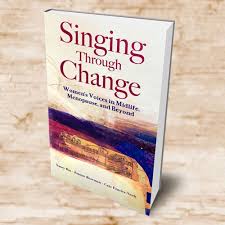Book Review: Singing Through Change
 Tl;dr: this is a useful book, and you should read it.
Tl;dr: this is a useful book, and you should read it.
Singing Through Change: Women’s Voices in Midlife, Menopause, and Beyond is, as you would imagine, relevant to the vast majority of people involved in singing. If you are a man who never makes music with adult women it may not touch on your activities very much (though you may well have female friends and relatives who would be happy for the men in their life to have some insight into their experiences), but for everyone else there will be direct relevance either for yourself, for the women you make music with, or both.
It is an accessible book, written for a non-specialist audience. It goes into some technical detail with regard to the vocal mechanism, and some medical detail about the kinds of changes brought by menopause, but always with explanations. It doesn’t assume prior knowledge, that is, but it does assume the desire and capacity to acquire it. It could perhaps have done with some diagrams in places as well as anatomical descriptions, on the Alice in Wonderland principle that there’s no point in a book without pictures and conversations.
Conversations, on the other hand, it has aplenty. Or at least, stories. Much of the book’s content is communicated through the accounts of 56 women who have generously shared their musical, medical, and personal histories with the authors, and the narrative quotes their own words frequently, especially when talking about the impact their experiences had upon them.
The approach as a whole reminded me of a very-light-weight version of Shere Hite’s classic study of female sexuality. (Goes to check shelf having not read that for years, and discovers it no longer to be there; guess that’s why I’ve not reread it recently then.) The integration of medical detail with a commitment to telling the story in the respondent’s own words is a very effective way of communicating knowledge by situating it real people’s lives. And it tells you something about the research agenda: it allows women to be the primary authors of their own experiences by speaking directly to the reader.
This approach not only makes for very engaging reading, it also provides clear support for one of the book’s main points: that how the same basic life process plays out for individuals can vary significantly, and both affects and is affected by what else is going in your life circumstances. Family situation, other health issues, and socio-economic context all influence both the physiological and emotional effects of menopause, and how different people respond to them.
Indeed, one of the big take-aways for me is that it is all too easy for three different types of process – the menopause itself, other unrelated medical conditions, and the general process of ageing – to get tangled up. You need to know whether your vocal issues are caused by hormonal changes or a thyroid condition.
The central lesson though is simply to know that the hormonal changes of perimenopause and menopause do often have significant impacts on the voice, in some cases as significant as those of puberty. And that during the transition, what had felt like a previously reliable and familiar instrument can go through periods of instability, leaving the singer feeling a worrying loss of control. Not everyone experiences this, but so many of the interviewees featured told of feeling isolated and full of self-doubt, and blaming themselves, it was quite heart-breaking.
This is why I said everyone needs to know about this. Should it happen to you, you’ll still have to deal with the instability, but you’ll know that it’s normal and have some idea of strategies to cope. If it happens to your friends, or people in your choir, you’ll be able to reassure them, and if needed help them source appropriate support.
I found myself with occasional reservations. The chapter on alternative therapies had my skeptic’s antennae twanging, not least with a passing reference to homeopathy, but actually most of the detailed case studies were more of the type I’d characterise as complementary therapies of the down-to-earth and not particularly woo kind. I’d not heard of Equine Assisted Therapy, but the account of its positive impacts made sense: a holistic combination of physical fitness, emotional connectedness and enhanced coordination and bodily awareness.
And browsing through the bibliography I found one article I had explicitly critiqued in one of my papers last year as pseudoscience for the way it speculatively extrapolates studies’ results beyond their original contexts in order to claim a spurious empirical backing for ideological beliefs. Which made me wonder somewhat about the robustness of the underlying scholarship as a whole.
But on the whole, I felt I could trust the conclusions. The authors are careful not to over-step the mark from giving information to giving advice, and focus on signalling the different kinds of help available, their uses, and how to get the best out of them. And the book opens with a quotation from Bertha Calloway that feels particularly relevant for our times:
We cannot direct the wind, but we can adjust the sails.
...found this helpful?
I provide this content free of charge, because I like to be helpful. If you have found it useful, you may wish to make a donation to the causes I support to say thank you.
Archive by date
- 2025 (24 posts)
- 2024 (46 posts)
- 2023 (51 posts)
- 2022 (51 posts)
- 2021 (58 posts)
- 2020 (80 posts)
- 2019 (63 posts)
- 2018 (76 posts)
- 2017 (84 posts)
- 2016 (85 posts)
- 2015 (88 posts)
- 2014 (92 posts)
- 2013 (97 posts)
- 2012 (127 posts)
- 2011 (120 posts)
- 2010 (117 posts)
- 2009 (154 posts)
- 2008 (10 posts)









